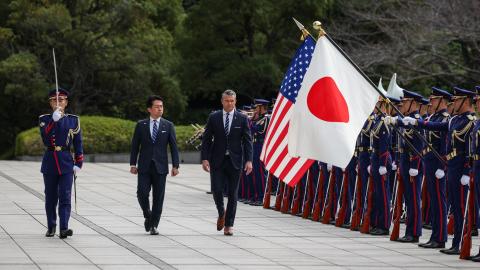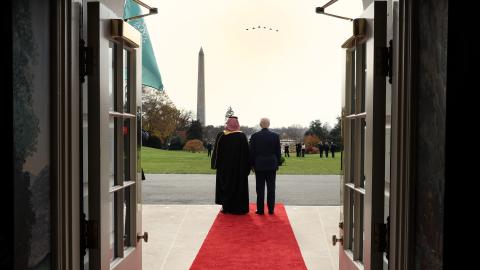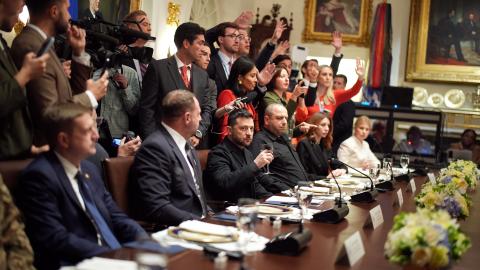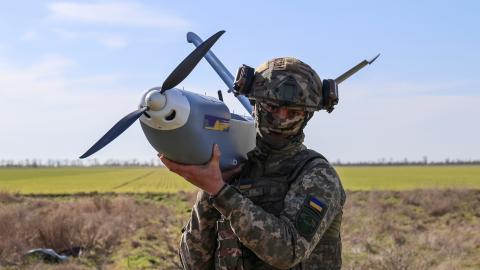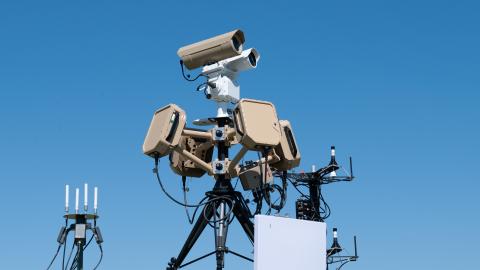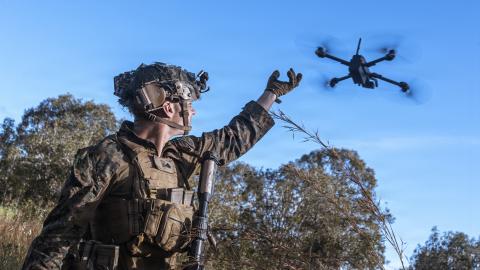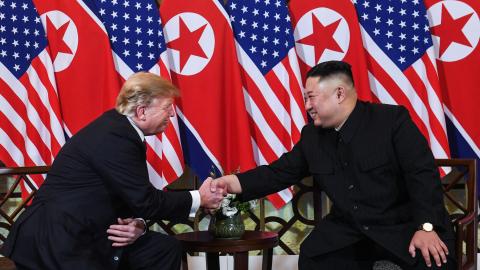No one should be surprised if, in the coming months, the leaders of the United States and North Korea seek to recapture their brief, shining moment of promise in June 2018. The Singapore summit marked the first-ever meeting of a sitting American president and chairman of the ruling party of the Democratic People’s Republic of Korea (DPRK or North Korea). Although the resulting four-part joint statement lacked detail or an operational plan of implementation, it nonetheless suggested that longstanding structural, strategic, and ideological divisions that could trigger a nuclear war on the Korean Peninsula might yet be amenable to at least stable coexistence. The Republic of Korea (ROK or South Korea) also may lean into high-level diplomacy to help restore peaceful coexistence with the North.
Meaningful diplomatic progress should be tangible, not just superficial. Yet both the failure of past efforts to find and sustain a breakthrough in U.S.-DPRK relations, and current troubles in world affairs, suggest extreme caution before leaping to the belief that summit diplomacy, even between two strongmen, can dissolve deepseated distrust and clashing national interests. This caution becomes all the more vital amid regional doubts about America’s reliability as a security guarantor and economic partner, and North Korea’s growing conviction that Russia and China are united in their aim to undermine U.S. influence.
This policy brief addresses five basic questions: What is likely to spark a new round of U.S.-DPRK summitry? What are the likely aims of renewed high-level diplomacy between Washington and Pyongyang? How might the two governments approach a resumption of top-level diplomatic engagement? What are some of the serious implications of another round of interaction between President Trump and Chairman Kim on the U.S.-South Korea alliance and regional security? Finally, what essential guidelines should shape U.S. policy as officials consider direct leader-to-leader contacts with North Korea?
Why Summitry Remains Alluring
Despite their many differences, both Donald Trump and Kim Jong Un have exhibited a great confidence in their ability to shine on the world stage and a desire to deal directly with other strong leaders. There is also the fact that summitry provides immediate gratification, altering atmospherics without necessarily touching substance. Summits may be useful for breaking the ice between rivals, amplifying agreements hammered out ahead of time, or closing a deal that is wanted on both sides but requires top-level decision-making to finalize it. Singapore was an icebreaker. The joint statement emerging from the initial summit may have been succinct, but the optics were glowing, and President Trump would subsequently declare that he averted “nuclear holocaust” through his direct engagement with the North Korean leader.
Of course, the Trump-Kim summit in Hanoi failed to be a deal-closer. The two sides were too far apart: Kim did not want to stop building nuclear weapons or at least weapons-grade fissile material; Trump did not want to remove major sanctions while Pyongyang could continue expanding its nuclear and missile arsenals.
Still, the renewal of direct, top-level diplomacy with North Korea is likely for both the United States and South Korea in the months ahead. Both leaders are well aware of their past encounters, but the American president is a determined deal-maker and the North Korean leader aspires to wield influence in all the capitals of the region’s major powers. President Trump has repeatedly expressed an interest in resuming his “great relationship” with Chairman Kim, and the White House announced early in Trump’s second term that he was already in “communication” with Pyongyang.
Less clear is the level of Kim’s general desire to re-engage President Trump. But the changing of the guard in Seoul after the June 3rd special election provides a new stimulus to President Trump’s affinity for personal top-level diplomacy. As in 2018, Seoul will be encouraging, not obstructing, outreach to Pyongyang.
Under President Yoon Suk-yeol, North-South relations plummeted. From beginning to end, Yoon hewed to strict reciprocity and alliance strengthening: his inaugural address promised North Korea an “audacious plan” if it “genuinely” moved toward “complete denuclearization;” in a successful White House visit, Yoon expanded the “nuclear” dimension of the alliance with the Washington Declaration; at Camp David he elevated trilateral security relations with Japan; in his National Security Strategy he touted South Korea as “global pivotal state;” and in Yoon’s 8.15 unification doctrine he called for change by North Korean citizens, suggesting a bottom-up regime change and ROK absorption of the DPRK. Kim Jong Un sought to retain the initiative, consistently taking a hardline approach to the Yoon government. Kim declared the South the “principal enemy,” renounced unification, razed symbols of inter-Korean ties, and launched trash balloons into the South. After an uncertain six-month interregnum in South Korean policy between the December impeachment of Yoon and the June election of Lee Jae-myung, the South’s interest in dialogue with Pyongyang has turned 180 degrees.
In his inaugural address, President Lee immediately signaled a change of course, underscoring South Korea’s K-democracy and remarkable cultural soft power. He vowed to “heal the scars of war and division.” Lee followed his rhetoric with a unilateral, low-risk gesture of turning off loudspeakers blaring music across the demilitarized zone (DMZ); North Korea reciprocated, pushing the pause button on the last year of “audio aggression.” The repatriation of six North Koreans rescued drifting in South Korean waters represented another unilateral gesture of goodwill by President Lee.
Less visibly, the Lee administration seems predisposed to encourage Trump-Kim diplomacy, provided that Seoul is not cut out of the loop. During Trump’s first term, Washington was sensitive to the idea that the Moon administration wanted to accelerate peace talks ahead of progress on denuclearization; during Trump 2.0, Seoul is likely to be wary of being left behind, particularly given the mixed signals of tariffs and calls for burden-shifting.
Yet the bigger impediment to inter-Korean diplomacy may be the near-alliance-like relationship that North Korea has built with Russia. North Korea’s provision of munitions and troops for Russia’s war against Ukraine has led to a comprehensive strategic partnership, the transfer of perhaps vital military technology to Pyongyang, and the release of video showing Russians praising North Korea and photos of Kim mourning the loss of North Korean troops.
Dueling Aims of Renewed Diplomacy
The road to another Trump-Kim meeting appears more plausible today than it has at any time since the last Trump administration. Still, what would be on the agenda of the next summit? Will diplomacy continue to pursue simultaneous denuclearization and peace, or will it aim to sequence those two objectives? Further, how might those goals be defined in terms of practical measures?
There is no consensus among American experts about the most basic strategic objective or specific policy goals of renewed U.S.-North Korean engagement. As a recent report co-published by the Hudson Institute and the Chey Institute for Advanced Studies reveals, one cleavage among North Korea watchers is between those who insist on grappling with the nuclear danger directly through deterrence and arms reduction or denuclearization, and those who see the best path forward as deriving from redefining the state of political hostility to establish a basis for trust and cooperation down the road. References to my co-authors of that report mentioned below can be found online in the study entitled, Deals, Deadlocks, and Deterrence.
Vipin Narang, who held a key post in the Biden administration’s Pentagon, helping to shore up extended deterrence with South Korea, holds fast to the argument that the U.S. must stay focused on the critical issues surrounding the growing nuclear dangers. That requires deterring any potential North Korean nuclear use while also dissuading South Korea from pursuing an independent nuclear arsenal. The dual challenge lies in both mitigating the direct threat posed by North Korea and preventing secondary proliferation, particularly on the Korean Peninsula. A South Korean nuclear breakout could trigger cascading regional consequences, including heightened conventional tensions and potential arms races. While Narang supports diplomatic engagement with Pyongyang, he emphasizes the need for the United States and South Korea to rebuild leverage before “rushing into a deal out of desperation.” Reinvigorating alliance deterrence capabilities, in his view, is essential to restoring a credible negotiating position.
In contrast to Narang, the Stimson Center’s Jenny Town, the U.S. Institute of Peace’s Frank Aum, and the Executive Director of the National Committee on North Korea’s Keith Luse, are eager to move swiftly to put the brakes on the downward spiral in relations with North Korea. If Aum envisions kick-starting a new rapprochement by freezing weapons testing in exchange for scaling back large-scale exercises, Luse sees the benefit in leader-to-leader reengagement as a means of stabilizing relations between Washington and Pyongyang. Town makes the case of a more realistic reading of North Korea’s durability. Assuming “the country will likely be around for the long haul,” Town wants to prioritize peace over denuclearization, thereby transforming the basic relationship from which to work forward.
Beyond the basic division between those focused on nuclear danger and those focused on political peace, the differences among U.S. experts widen further regarding the general policy aims of diplomacy. Narang seeks to implement a set of alliance measures for bolstering extended deterrence combined with practical measures for averting nuclear proliferation or employment. Toward that same goal, former Six-Party Talks Ambassador Joseph DeTrani wants to pursue an end to North Korean fissile material production, an issue that has been at the center of the ongoing conflict with Iran.
But Town favors a bold gesture to formally end the state of war that still exists on the peninsula. “For too long,” writes Town in the same Hudson-Chey Institute report, “peace treaty negotiations have been kicked down the road for a myriad of reasons,” and she argues that “durable peace and stability on the Korean Peninsula require a final resolution to the Korean War.” An agreement on ending the war could open up negotiations on the nuclear issue, risk reduction, the pace of normalization, and regional security.
There is a basic common understanding that no one expects North Korea to relinquish its nuclear weapons— something even less likely after Israel’s and America’s bombing campaign to eliminate Iran’s nuclear weapons program. The bold airstrikes may well spur Iran to attempt to accelerate its quest for nuclear weapons; but for now, airpower has seriously damaged Tehran’s nuclear program, apparently setting it back from about six months to up to two years. Meanwhile, Pyongyang must be bolstered in believing that only nuclear weapons can prevent North Korea from being attacked. Even so, few are willing to concede the long-range goal of denuclearizing the Korean Peninsula
Alternative Approaches to Re-engagement
Whether the policy priority is nuclear stability or political stability, there is a finite set of approaches Washington can take for resuming diplomacy with North Korea. Some experts such as Keith Luse, hoping for a far more ambitious diplomatic campaign to lower tensions with North Korea, are willing to consider using a TrumpKim summit to change the optics of the relationship, while others such as Jenny Town support unilateral political and military confidence building measures to initiate a virtuous cycle of relations. But the default governmental approach to North Korea remains customary cautious, action-for-action diplomacy.
There are few prudent alternatives to a measure-for-measure approach, especially given the long arc belligerence and short lifespan of trust and cooperation. Indeed, amid ongoing wars in Europe and the Middle East, North Korea has become an even more formidable challenge for diplomacy given its overt support for Iran and its deepening strategic alignment with Russia.
Unlike 2018, when North Korea appeared to be moving toward closer ties with Washington and Seoul at the expense of Moscow and Beijing, today the Kim regime remains bankrolled by Beijing and doubling down on its expanding alliance with Russia. As Pyongyang offers troops and workers for Russia’s aggression against Ukraine, Moscow appears increasingly willing to support Chairman Kim’s military plans. The top U.S. military officer in South Korea, General Xavier Brunson recently warned about the level of technology cooperation Russia appears to be giving North Korea. As long as Russia’s war against Ukraine continues, the MoscowPyongyang military cooperation is apt to deepen, as suggested by the third meeting between Kim Jong Un and Russian Security Council chief and former defense minister Sergei Shoigu suggests. President Trump may relish dealmaking and President Lee may champion inter-Korean reconciliation, but neither will be eager to negotiate with a North Korean leader who believes he holds the upper hand.
Another difference today is that Trump 2.0 is locked in on its “America First” approach to allies and partners, leading to tariffs and trade tensions with South Korea, demands for much higher levels of defense spending and burden-sharing, and reportedly mulling the withdrawal of 4,500 US troops from the peninsula. The ambivalence about the alliance may drive President Trump to unilaterally pursue summit diplomacy with Kim. Alternatively, it might lead him to sideline the North Korea issue altogether—effectively delegating it to Seoul—while Washington concentrates its attention on countering China.
Alliance and Regional Security Ramifications
North Korea’s deepening ties with Russia, coupled with the United States’ increasingly transactional and protectionist posture toward its allies underscore the broader stakes of renewed high-level U.S.-DPRK diplomacy. These developments are not taking place in isolation; they are unfolding in a region where perceptions of American commitment and credibility are under scrutiny.
At the heart of these concerns lies the evolving foundation of the U.S.–South Korea alliance. While the alliance is not predicated on any single threat, any move to reduce the U.S. military footprint or signal ambiguity on extended deterrence risks fueling the impression that the United States is disengaging from Asia’s key flashpoints. While the Trump administration may seek to compel allies to shoulder greater security responsibilities, such burden-shifting can be dangerously misinterpreted by adversaries as strategic retrenchment. For instance, Daryl Press has shown how current military posture may affect an adversary’s calculation. More dramatically, the U.S. decision to omit the peninsula from its defense perimeter that surely helped persuade Joseph Stalin to green-light Kim Il Sung’s plan for an outright invasion in 1950.
Efforts to discern a coherent strategy in the early months of President Trump’s second term remain challenging. Nowhere is this more evident than in U.S. policy toward China, which oscillates between intensified strategic rivalry with “Communist China” and bursts of high-level diplomacy aimed at “historic” deals and crafting a “grand bargain.” This ambiguity casts a long shadow over the future of China’s relations with North and South Korea—and with the United States itself.
Regional stability could be further shaken by a sudden crisis over Taiwan. A People’s Liberation Army (PLA) military drill might be a “fig leaf” an invasion, or it may simply represent part of Xi Jinping’s broader strategy to build comprehensive national power and slowly tip the regional balance in China’s favor without firing a shot. Either scenario becomes more plausible if Beijing perceives the U.S. as stepping back from its traditional regional role, and such an impression could embolden Pyongyang to advance its own revisionist ambitions.
U.S.–North Korea diplomatic reengagement would also reverberate strongly in Tokyo. Japan, a frontline stakeholder in any North Korean contingency, must be factored into any strategic calculus. Encouragingly, President Lee Jae-myung has signaled continuity in trilateral cooperation with Japan. His coordination with Prime Minister Shigeru Ishiba, particularly in the aftermath of President Trump’s early departure from the G7 to address the Iran crisis, spurred President Lee to describe South Korea-Japan ties as “inseparable.” As both leaders navigate an increasingly uncertain future, they would be wise to emphasize shared interests rather than re-litigate historical grievances. Seoul and Tokyo have far more to gain by working together to shape the region’s future than by remaining mired in its past.
Guidelines for America’s North Korea Policy
The 2018 Singapore summit marked a historic breakthrough, shattering decades of diplomatic inertia between Washington and Pyongyang. Yet despite the symbolic value of that initial meeting, the two subsequent TrumpKim encounters yielded diminishing returns. A fourth summit now carries the risk of reinforcing the perception that engaging North Korea’s supreme leader produces more spectacle than substance. Such a meeting should only be pursued if it is anchored within a clear, achievable strategy that advances the security interests of the United States, South Korea, and Japan alike.
The goal of denuclearization can remain a long-term aspiration, but it is not the basis for productive diplomacy in the near term. A phased approach centered on threat reduction, confidence-building, and nuclear risk mitigation offers a more pragmatic pathway. If diplomacy is to regain traction, it must be grounded in concrete steps, such as opening reciprocal liaison offices or institutionalizing leader-level communication. These moves would not resolve fundamental disagreements but could catalyze a sustained diplomatic track.
In the case of a fourth Trump-Kim summit, the U.S. must be careful to discern symbolic meetings and vague statements from concrete progress. Experience underscores the limits of summitry. North Korea has a track record of spurning diplomatic overtures and appears, at least in the near term, not eager to resume serious talks. While President Trump has already met Kim Jong Un three times, a fourth encounter no longer offers novelty or diplomatic shock value. Worse, the precedent of the failed February 2019 Hanoi summit—where the leaders departed without even a limited agreement, such as trading Yongbyon facility constraints for targeted sanctions relief—looms large. At a minimum, analysts should remain skeptical about claims President Trump could quickly resolve any conflict with North Korea.
The current geopolitical landscape further complicates matters. UN Security Council sanctions on North Korea are increasingly fragmented, while Pyongyang openly operates its uranium enrichment program and is reportedly constructing a new enrichment plant at the Yongbyon complex. Any future negotiation may demand that the United States pay a steep price for even modest nuclear concessions.
The ripple effects of the Russia-Ukraine war have already altered the strategic calculus in Asia. Now, the unfolding conflict involving Iran may further reshape global security dynamics. While Washington's immediate focus remains on the Middle East, the Korean Peninsula is unlikely to stay quiet indefinitely. When Pyongyang eventually signals interest, perhaps by responding to one of President Trump’s “beautiful” letters, the United States must be ready with a coherent game plan that avoids past pitfalls and maximizes diplomatic leverage.
Read in The George Washington University Institute for Korean Studies.
